At last month’s International Vision Expo East, attendees saw the latest lab equipment and supplies. L&T’s editors were on the show floor taking notes. Here’s their special report on what’s new and noteworthy in lens processing technology.
 Lens finishing equipment is always of prime interest to Expo attendees and vendors introduced a number of impressive new products at last month’s show. AIT’s Maxima Evolution offered efficiency, reliability and versatility, with multiple wheel configurations for high-luster polish and the ability to tackle any material. In addition, the Maxima Evolution features new technology for processing wrap frames. Finally, its housing structure features advanced noise-reduction technology to make it one of the quietest edgers in the industry. AIT will be offering show specials complete with special financing options.
Lens finishing equipment is always of prime interest to Expo attendees and vendors introduced a number of impressive new products at last month’s show. AIT’s Maxima Evolution offered efficiency, reliability and versatility, with multiple wheel configurations for high-luster polish and the ability to tackle any material. In addition, the Maxima Evolution features new technology for processing wrap frames. Finally, its housing structure features advanced noise-reduction technology to make it one of the quietest edgers in the industry. AIT will be offering show specials complete with special financing options.
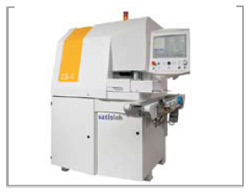 The ES-4 from Satisloh edges to the smallest B measurement—18.5 mm—and features variable angle drilling for variable depth, elongated holes, and widening holes to any diameter.
The ES-4 from Satisloh edges to the smallest B measurement—18.5 mm—and features variable angle drilling for variable depth, elongated holes, and widening holes to any diameter.
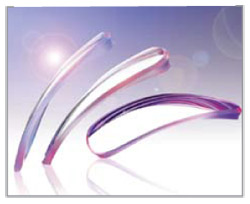 Santinelli International released its high-base curve technology in two additional lens edger models. The same patented beveling process that premiered in the Lex 1000 Lens Edger is now available on the company’s ME-1000 Design+ and SE-9090 Express+ Industrial models. In addition, the SE-9090 Express+ is capable of polishing the high-curve bevel. This technology offers the best bevel profile for high-curved lenses by processing the front and back bevel independently. This process creates a consistent and custom profiled bevel around the circumference of the lens. The result is a perfect fit and a precise bevel every time, for a flawless look, according to Santinelli.
Santinelli International released its high-base curve technology in two additional lens edger models. The same patented beveling process that premiered in the Lex 1000 Lens Edger is now available on the company’s ME-1000 Design+ and SE-9090 Express+ Industrial models. In addition, the SE-9090 Express+ is capable of polishing the high-curve bevel. This technology offers the best bevel profile for high-curved lenses by processing the front and back bevel independently. This process creates a consistent and custom profiled bevel around the circumference of the lens. The result is a perfect fit and a precise bevel every time, for a flawless look, according to Santinelli.
Briot USA’s Digiform Plus provides the Accura edgers (Silver, Silver Plus and CX) with the capability to do shape modification for customized jobs. The software also saves frame tracings and virtually an unlimited number of original and modified rimless shapes in the computer’s hard drive. Proportional shape modification increases/decreases entire shape proportionately; vertical shape modification is dedicated to near vision fitting in narrow rimless frames; horizontal shape modification adapts rimless frames to wide faces. Job storage function allows permanent storage and easy access of frame tracing data. Pattern storage allows for faster, more simplified process when processing all rimless frame styles. Frame shape is stored in computer database, eliminating the need to manually trace each job.
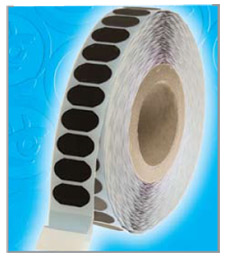 Among the new consumables for lens finishing was the HydroTech blocking pad from OptiSource. Designed to facilitate the edging of hydrophobic, AR lenses, HydroTech features a proprietary rubber substrate and utilizes nano-adhesive technology. The pad structure, adhesive system and characteristics of this pad are uniquely suited to meld to the slickest low surface energy coatings, but remove cleanly after edging. Hydrotech is shaped and lined in a format to work in automatic robotic applicators, but can be applied by hand as well. In side-by-side comparisons Hydrotech has proven to reduce breakage more than any other pad in its category, according to OptiSource.
Among the new consumables for lens finishing was the HydroTech blocking pad from OptiSource. Designed to facilitate the edging of hydrophobic, AR lenses, HydroTech features a proprietary rubber substrate and utilizes nano-adhesive technology. The pad structure, adhesive system and characteristics of this pad are uniquely suited to meld to the slickest low surface energy coatings, but remove cleanly after edging. Hydrotech is shaped and lined in a format to work in automatic robotic applicators, but can be applied by hand as well. In side-by-side comparisons Hydrotech has proven to reduce breakage more than any other pad in its category, according to OptiSource.
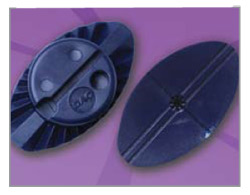
DAC Vision’s Stellar flexible edging blocks feature a side design that allows the block to conform to its curve and match most lens surfaces. Its exclusive plastic material allows flexibility or rigidity when needed. Thanks to its unique size combination it can be used for both large and small frames. The narrow “B” dimension does not interfere with edger operation, eliminating time consuming hand work that can increase breakage.
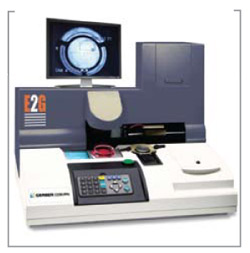 In the lens surfacing equipment arena, Gerber Coburn exhibited its eco-friendly E2G Blocking System, consisting of the E2G blocker, new surface blocks, a deblocker and a proprietary blocking medium called Onyx-Bond. Onyx-Bond is reusable, machinable and environmentally safe. Because the material is neither wax nor alloy, it eliminates the harmful effects of alloy and EPA issues associated with alloy contamination, while removing lens cleanup issues attributed to wax materials. Onyx-Bond is completely compatible with AR coatings and allows knife-edge and digital (free-form) lenses to be produced to the specifications required. All of this is done without damage to the lens or to generator cutting tools.
In the lens surfacing equipment arena, Gerber Coburn exhibited its eco-friendly E2G Blocking System, consisting of the E2G blocker, new surface blocks, a deblocker and a proprietary blocking medium called Onyx-Bond. Onyx-Bond is reusable, machinable and environmentally safe. Because the material is neither wax nor alloy, it eliminates the harmful effects of alloy and EPA issues associated with alloy contamination, while removing lens cleanup issues attributed to wax materials. Onyx-Bond is completely compatible with AR coatings and allows knife-edge and digital (free-form) lenses to be produced to the specifications required. All of this is done without damage to the lens or to generator cutting tools.
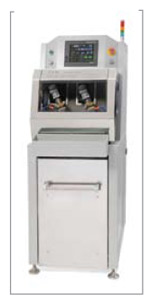 The E2G blocker features one-touch blocking, automatic block and lens detection, and high volume throughput. It allows for full diameter blocking, which eliminates lens edge chatter issues by providing maximum support and stability during the generating process. With the single block design, block-to-lens curve matching is no longer required, thus saving time and reducing block inventory. The newly designed blocks are available in Acublock or standard pin style and are fully compatible with downstream advanced lens processing equipment.
The E2G blocker features one-touch blocking, automatic block and lens detection, and high volume throughput. It allows for full diameter blocking, which eliminates lens edge chatter issues by providing maximum support and stability during the generating process. With the single block design, block-to-lens curve matching is no longer required, thus saving time and reducing block inventory. The newly designed blocks are available in Acublock or standard pin style and are fully compatible with downstream advanced lens processing equipment.
The new deblocker easily removes the Onyx-Bond in a single wafer form, leaving no residue on the lens. Once deblocked, the Onyx-Bond is placed back into the E2G premelter, where it is remelted and ready for continued blocking.
DAC International demonstrated the latest version of the NSLP Soft Lap Polisher. The NSLP now utilizes a new and proprietary control algorithm that sets lens and lap spindle speeds, pressure and variable lap head velocity to suit lens material, curve, diameter and topography. The operator needs only to enter (or scan) the tray number and the information is automatically retrieved. The NSLP interfaces with the RxD Lathe in a closed network, eliminating the need to interface the polisher with the lab host.
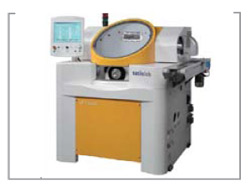 Satisloh displayed the high-speed VFT-orbit generator. Engineered for processing All-Format lenses, the VFT-orbit’s throughput is hefty—while its size is streamlined and compact—making it an easy addition to any size lab. The VFT-Orbit produces up to 100 lenses per hour in “cut to polish” mode and generates both conventional and free-form surfaces—that’s 15 percent to 25 percent faster than even Satisloh’s VFT-Ultra.
Satisloh displayed the high-speed VFT-orbit generator. Engineered for processing All-Format lenses, the VFT-orbit’s throughput is hefty—while its size is streamlined and compact—making it an easy addition to any size lab. The VFT-Orbit produces up to 100 lenses per hour in “cut to polish” mode and generates both conventional and free-form surfaces—that’s 15 percent to 25 percent faster than even Satisloh’s VFT-Ultra.
 Schneider Optical Machines showcased the HSC Sprint digital surfacing generator. This versatile unit is designed for smaller labs as well as larger labs with dedicated production lines. Includ-ing all the components needed for the consistent production of high-quality Rx and free-form lenses, the HSC Sprint design is exceptionally small and inexpensive. When matched with Schneider’s CCP Swift polisher, the HSC Sprint is the industry’s most compact direct surfacing line. The entire Sprint line, including the CB Bond blocker and the CCL C*mark laser marking unit fit on less than eight square feet.
Schneider Optical Machines showcased the HSC Sprint digital surfacing generator. This versatile unit is designed for smaller labs as well as larger labs with dedicated production lines. Includ-ing all the components needed for the consistent production of high-quality Rx and free-form lenses, the HSC Sprint design is exceptionally small and inexpensive. When matched with Schneider’s CCP Swift polisher, the HSC Sprint is the industry’s most compact direct surfacing line. The entire Sprint line, including the CB Bond blocker and the CCL C*mark laser marking unit fit on less than eight square feet.
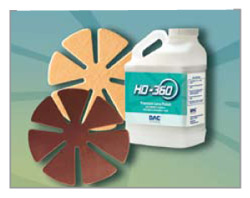 Among the new consumables introduced at Expo East was DAC Vision’s Synchrony System. The innovative system for processing polycarbonate lenses offers advanced technology that is especially formulated to work together delivering unsurpassed results. The New Velocity One-Step Fining Pad for polycarbonate reduces fining times with consistent stock removal and excellent surface quality, according to DAC Vision. It works on all generator surfaces. New Lumina is a premium polishing pad. Its construction employs a mixture of fiber lengths and densities that place polish on the lens surface where it’s needed and reduces slurry carry-out. HD-360 premium lens polish offers improved clarity with reduced polycarbonate haze, providing a superior surface for eventual coating.
Among the new consumables introduced at Expo East was DAC Vision’s Synchrony System. The innovative system for processing polycarbonate lenses offers advanced technology that is especially formulated to work together delivering unsurpassed results. The New Velocity One-Step Fining Pad for polycarbonate reduces fining times with consistent stock removal and excellent surface quality, according to DAC Vision. It works on all generator surfaces. New Lumina is a premium polishing pad. Its construction employs a mixture of fiber lengths and densities that place polish on the lens surface where it’s needed and reduces slurry carry-out. HD-360 premium lens polish offers improved clarity with reduced polycarbonate haze, providing a superior surface for eventual coating.
 Practical Systems, Inc. (PSI) introduce the Red Revolution one-step fining pad for all lens materials. This innovative pad offers a new abrasive structure and film backing designed specifically for polycarbonate lenses. The abrasive’s structure is precisely graded so it is aggressive enough for poly but fine enough to be used on all other plastic lens materials, allowing labs to reduce pad inventories and keep costs down. It has a new mid-tack adhesive system that offers high performance and conformability on both bare lap tools and base pad applications. The film backing is highly compressible providing uniform stock removal and the ability to mask minor tooling imperfections reducing reworks. When used with PSI’s Pink Perfection polish pad and High Pro Polish under the right operating conditions, the Red Revolution pad can cut cycle times down by as much as 50 percent. The Red Revolution pad comes in a three-inch round or tabbed seven-petal configuration on a roll of 250.
Practical Systems, Inc. (PSI) introduce the Red Revolution one-step fining pad for all lens materials. This innovative pad offers a new abrasive structure and film backing designed specifically for polycarbonate lenses. The abrasive’s structure is precisely graded so it is aggressive enough for poly but fine enough to be used on all other plastic lens materials, allowing labs to reduce pad inventories and keep costs down. It has a new mid-tack adhesive system that offers high performance and conformability on both bare lap tools and base pad applications. The film backing is highly compressible providing uniform stock removal and the ability to mask minor tooling imperfections reducing reworks. When used with PSI’s Pink Perfection polish pad and High Pro Polish under the right operating conditions, the Red Revolution pad can cut cycle times down by as much as 50 percent. The Red Revolution pad comes in a three-inch round or tabbed seven-petal configuration on a roll of 250.
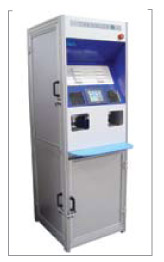 A number of new lens coating technologies were also unveiled at Expo East. Chemat Vision released its new version of the Chemalux 300 Coating System with a new treatment module. This module consists of special radiation curing for minute fast AR curing and for enhanced AR performance. Chemalux 300 System is an automatic dual lens coating system with the full integration of high pressure water wash, corona surface treatment, multilayer AR coating steps. This system is affordable, compact and easy to use so that it is ideal for the small optical labs to do AR coatings in house.
A number of new lens coating technologies were also unveiled at Expo East. Chemat Vision released its new version of the Chemalux 300 Coating System with a new treatment module. This module consists of special radiation curing for minute fast AR curing and for enhanced AR performance. Chemalux 300 System is an automatic dual lens coating system with the full integration of high pressure water wash, corona surface treatment, multilayer AR coating steps. This system is affordable, compact and easy to use so that it is ideal for the small optical labs to do AR coatings in house.
 The EZ Coat System from Quest Optical is an affordable, operator friendly, high-quality hard-coating machine. The system combines a high-pressure wash, a superior coating application station and the most efficient curing oven. The combination of the three-in-one system provides optimum cleaning, exact coating thickness and the hardest possible coating cure of all the spin coaters.
The EZ Coat System from Quest Optical is an affordable, operator friendly, high-quality hard-coating machine. The system combines a high-pressure wash, a superior coating application station and the most efficient curing oven. The combination of the three-in-one system provides optimum cleaning, exact coating thickness and the hardest possible coating cure of all the spin coaters.
According to Quest, the EZ Coat System offers good value, combining a sleek stainless stain or anodized aluminum single cabinet design and sophisticated yet simple controls. The EZ Coat System measures a small footprint of L 27” x W 28” x H 29” and comes in either 110 volts or 220 volts.













